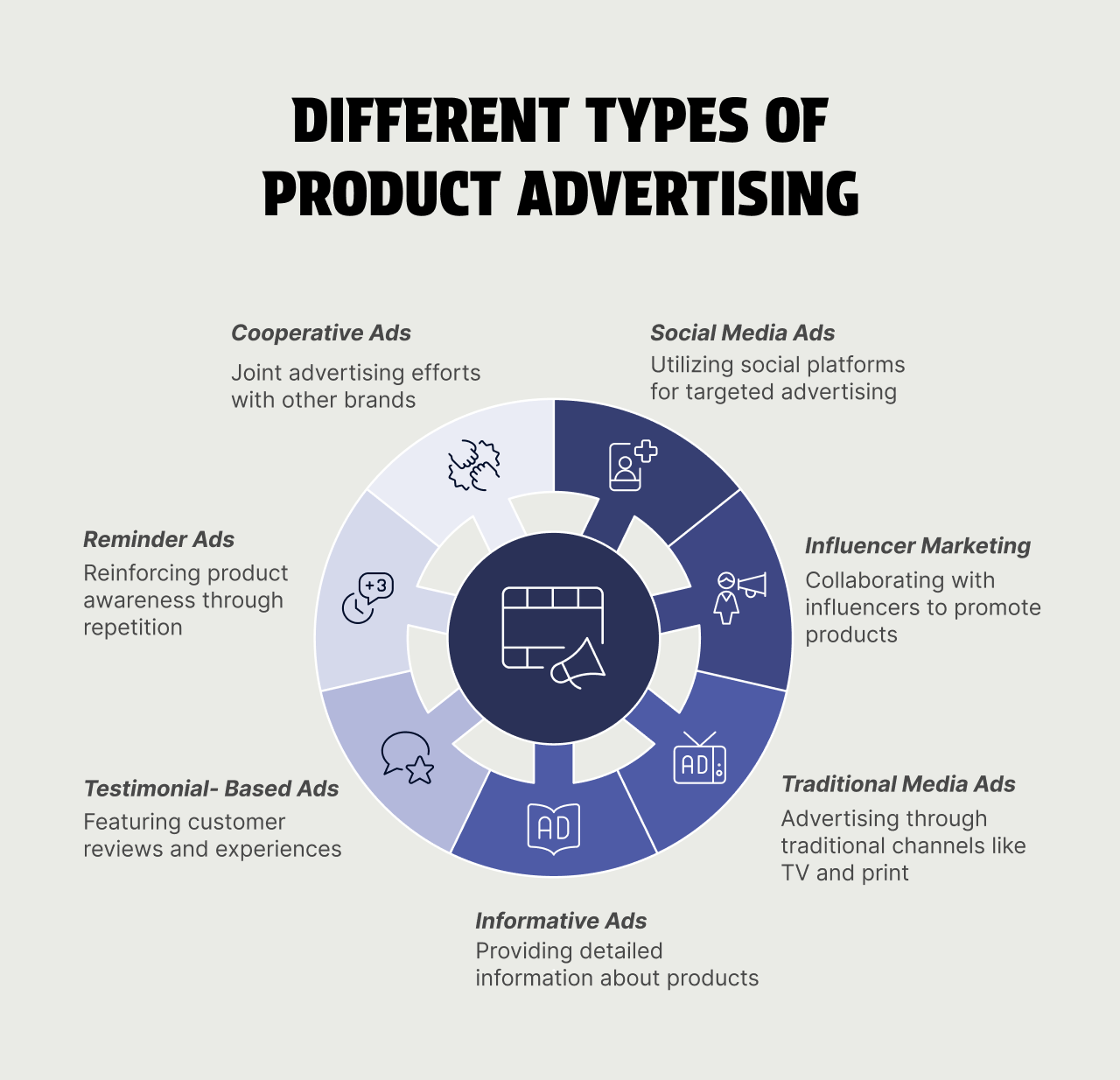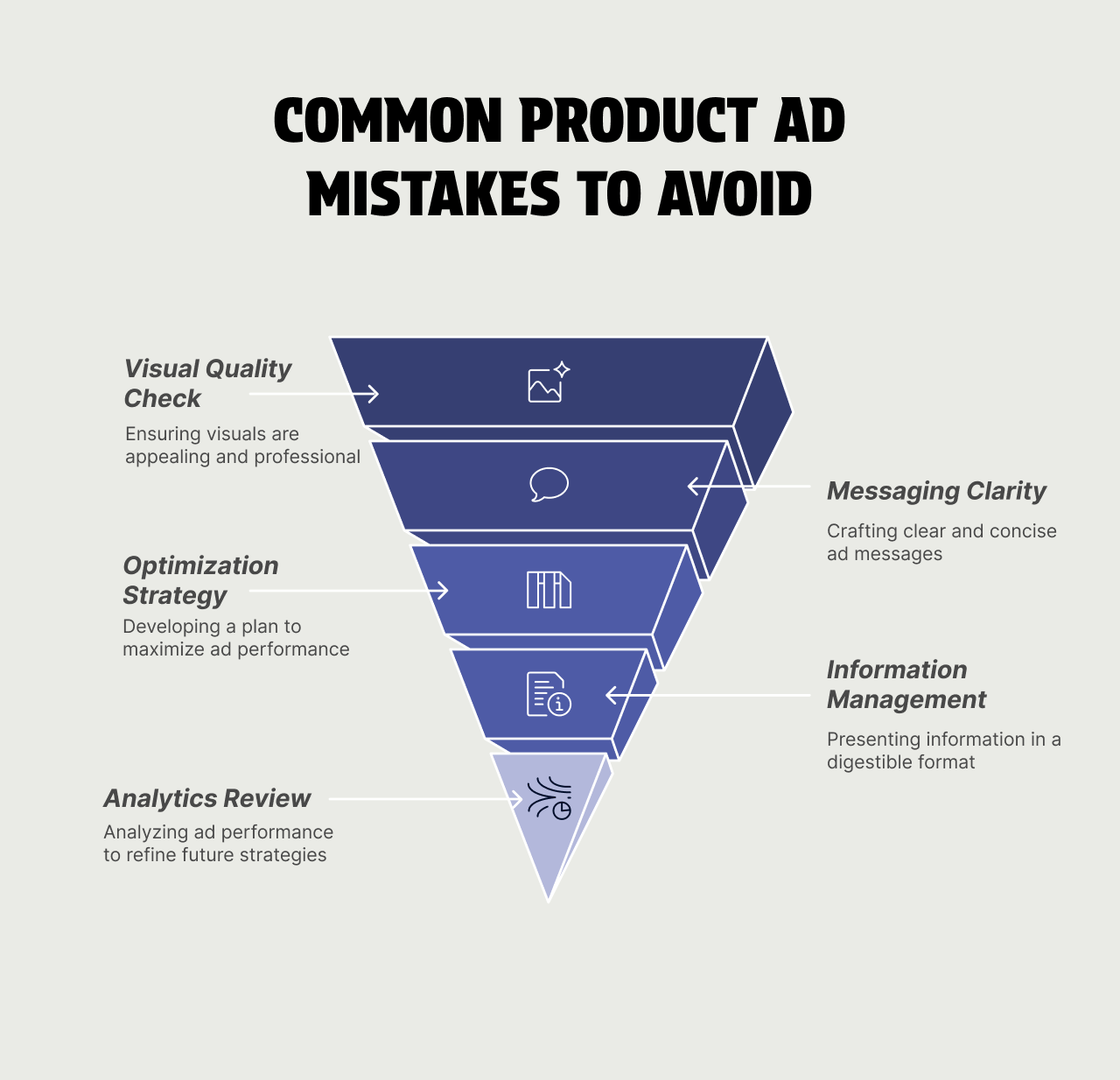Have you ever wondered why we all remember one or more product advertisement taglines from several years back till now? The reason is simple: they were well advertised using beautiful creatives so much so that you still recall that brand. This small nuance shows the importance of product advertising and how it can affect people's psychology.
What is Product Advertising?
Product advertising is a strategy to promote and showcase a product, service, or idea through multiple online and offline mediums. It aims to create engaging, informative, and persuasive content highlighting product specifications and benefits.
When advertising, you try to tell a story about -
- What actually your product is?
- How It is made?
- What benefits It can offer?
- and how different it is from other products?
It helps to reach a wider set of customers.
What makes Product Advertising so Effective? (7 Major Benefits)

1. Get More People to Know your Product
Advertising makes a product visible to potential customers. When a new brand decides to enter the market, advertising its product helps them gain visibility and recognition.
2. Boosts Customer Engagement
Customers engage with a product only if they are intrigued enough to learn more. To grab customers' attention, highlight the product’s features, use cases, or reviews with the right messaging.
3. Builds Long-Term Brand Trust
Promoting a product minimizes the gap between the user’s demand and the producer's supply. Consistent advertising establishes trust and credibility with customers.
4. Drive More Leads and Sales
As brand owners, the most important aspect of product advertising is sales/leads. Effective marketing of the product generates sales and revenue and builds your credibility amongst the competitors’ brands in the market.
5. Stands out from other Brands
When you remember the Maggi or Pepsi ad taglines, it means you differentiate these from their competitive brands. Advertising enables brand recall as well as retention from their customers.
6. Educate Customers about What You Offer
Digital advertisements currently enable marketers to analyze ad performance based on various parameters, such as demographics, conversion rate, high-selling products, and more. They also provide valuable insights into customer behavior and choices.
7. Ensures Brand Consistency
Any brand must continuously build relationships with consumers. Regular effort in promoting the brand leads to long-term, sustainable growth and fulfills customer interests and needs.
What Are the Different Types of Product Advertising? (With Examples)

1. Social Media Advertising
This kind of product advertising uses social media networks' enormous user bases and advanced targeting features to deliver creative ad copies to potential customers.
Depending on the platform and objectives, one can run social media ads in different forms, including sponsored posts, banners, video ads, or stories.
Key Features of Social Media Advertising Are -
- Advanced Targeting
- Real Time Monitoring
- Retargeting
- Economical
- Creative & Engaging
2. Influencer Marketing Campaigns
The influencer marketing industry is set to be worth $48 billion in 2027; the data is enough to suggest why this type of marketing has been utilized by brands lately.
Content creators and industry professionals directly engage with the customers and get their trust built over time. Brand collaboration in the form of sponsored posts and reviews yields higher conversions/sales.
3. Traditional Media Advertising
Traditional advertising is still relevant and has a significant role in reaching a wider audience, increasing a brand’s credibility, and thus leaving a long-lasting impact.
- Television Ads
- Print Ads/Newspaper/Magazine Ads
- Brochure/Flyers/Billboard Ads
4. Informative Product Ads
The main objective of informative advertising is to convey helpful information that explains the product's advantages, characteristics, and applications rather than to persuade or manipulate customers. Informative product advertisements are best suited for B2B companies that offer high-end technology-enabled solutions to clients.
5. Testimonial-Based Product Ads
Testimonial product advertising uses actual consumers, celebrities, influencers, or industry professionals to offer gratifying comments or recommendations on a good, service, or brand. By highlighting the experiences and viewpoints of people who have used the product or service, the aim is to gain the confidence and trust of new customers.
6. Reminder Ads for Re-Engagement
Reminder advertising caters to the needs of customers who have interacted with, purchased, or shown interest in the brand’s product. The ad serves the purpose of brand recall so that customers might engage again.
7. Cooperative Advertising
It is a collaborative form of product advertising, where multiple companies come together to promote the product by sharing the expenses.
In most cases, manufacturers or distributors (TV channels or Google Ads) bear the cost of advertising and provide a platform for retailers to market the product. This mutual partnership helps both parties gain visibility and profits with shared expenses.
Now that we know the definition as well as the benefits of advertising, let’s learn how it is done.
How Do You Create a High-Converting Product Ad?
1. Define Your Product and Targeted Audience
Create a buyer persona to understand potential customers by studying their demographics, interests, and associated platforms.
Before entering the market, you must conduct detailed research on
- Product Demand
- Existing Gaps, and
- Threat Studies.
Then, define your unique selling point and campaign objective for the ad.
2. Design a Clear Ad Creative
The visual and creative element stands out the most. The ad needs to be visually appealing to your targeted consumers. The use of an, interactive banners, or eye-catching tagline takes it to another level. Choose the best ad format (TV, flyers, billboard, or Instagram) based on where your users like to spend time.
3. Budget & Plan the Production Wisely
Based on the goals and target audience, decide how much money will be spent on the advertising campaign and distribute it across the various channels. Budget allocation should be done by keeping media buying, post-production, and other expenses in mind.
Latest: 8 Ways to Reduce Wasted Ad Spend and Increase Returns
4. Launch & Distribute the Ad
Use the selected channels and ads to carry out the advertising campaign. Keep an eye on the launch to make sure the ads show up properly and make any necessary adjustments if required.
5. Measure Results & Keep Optimizing
Measure the important metrics like clicks, impressions, conversion rate, and comments, and gather consumer opinions to determine how well the advertisement played out. Optimize the campaign by modifying creative components, improving targeting, or reallocating funds to more efficient channels as per the analyzed data to achieve the desired objective.
Recommended Read: 7 Easy Steps to Advertise a Product for Beginners
What Are Some High-Converting Product Ad Examples?
In the past few years, digital advertising has been indubitably the most targeted, dynamic, and goal-driven medium for advertising your product. It allows marketers to target audiences through goals, demographics, behaviors, and interests.
1. Social Media Product Ads by Ecommerce Brands
This is a widely used product ad example by retail and e-commerce brands for brand visibility, consideration, and sales. Unlike traditional advertising, a brand has access to target refined audiences (who are more likely to convert) and can manage expenses by measuring ROI.
2. Google Search and Display Ads
Search engines like Google and Bing offer advertising services where ads can be presented on users’ queries and similar interests for both web & mobile apps. This mode of product advertising works on the PPC (PAY PER CLICK) model, where advertisers are charged only when users click or interact with the ad.
Recommended: Top 10 Free Advertising Sites to Promote Your Business Online
3. Email Marketing Campaigns
Promotional messages are sent in the form of text or combined with some images to the users who have provided consent for receiving emails. It works well for reminder and retargeting advertising where users have interacted with the website before.
4. Engaging Video Advertisements
Ads presented in the form of videos generate more engagement and results. As per Wyzowl video marketing statistics, a lot of marketers report that using video has helped increase website traffic.
Check these 8 Brilliant Interactive Ad Examples (with Live Preview)
What Are the Latest Trends in Product Advertising in 2025?
The future of product advertising is going to be highly personalized and innovative. We will see a steep transition of traditional advertising being overpowered by engaging digital advertising in the next decade.
Many brands, including Mercedes-Benz, Nike, BMW, ClickUp, and Meta, have been incorporating AI-generated ads for their marketing. Let’s dive into what lies ahead for a brand in terms of advertising their products.
1. Interactive and AI-Powered Ads
Brands are now advertising their products with creative and highly engaging ads. Rich media and data-driven, AI-enabled interactive ads allow real-time customization according to the customer’s preferences and queries and provide tailored messaging, making it highly personalized.
2. Shoppable Banners and Clickable Videos
With shoppable banners or video ads, marketers can use a single ad format to guide customers from awareness to purchase with the use of seamless interactive elements in the ad itself.
Marketers may improve their advertising by using the useful data insights that shoppable ads provide, such as click-through rates, conversion rates, and return on ad spend (ROAS).
Check: Top 5 Interactive Shoppable Video Platforms
3. Voice Search Advertising on Smart Devices
With the evolving customer voice search experience and the surge of newer technologies like Google and YouTube voice search, smart speakers, and voice assistants, brands need to optimize ads by keeping devices, languages, and contextual targeting in mind.
4. Short-Form Video Ads on Reels and Shorts
We already see the impact of short video/reel advertising on social media. It is the most prominent trend for product advertising done by collaborating with macro as well as nano influencers. Small video ads serve the purpose of communicating well with younger audiences, who have seemingly low attention spans.
5. Omnichannel Ad Strategy Across Platforms
Cross-platform integration and cross-device targeting can be companies' focus for the coming years. It could prove to be effective, economical, and more seamless for advertisers to promote a product on various channels for the same user.
6. OTT Advertising on Streaming Platforms
People use smart, internet-enabled TVs and over-the-top (OTT) video services to consume video content these days. Contextual advertising by studying the analytics, genre preferences, and watching habits can be implemented in the coming time.
7. Blockchain Integration for Ad Transparency
Keeping privacy and fraud concerns in mind, brands will move toward more secure and transparent platforms for advertising. The use of blockchain technology can ensure the building of trust and credibility for the advertisers in the market.
What Common Mistakes Should You Avoid in Product Advertising?

Mistake 1: Using Low Quality Visuals
The visual aspect of the ads must be eye-catching, appealing, and engaging. This is the first impression a customer gets when they see the product ad; it ought to be high quality and relevant to the messaging.
Mistake 2: Delivering Poor or Misleading Messaging
The messaging (text, song, or video) needs to be concise and clear; it shouldn’t give any false impression or promise to the consumers. Communication should be in line with the brand’s image and value.
Mistake 3: Ignoring Ad Optimization
Ads should be optimized according to the devices, platforms, and audiences. Neglecting mobile optimization can lead to lower CTR and visits.
Mistake 4: Stuffing Too Much Info Into One Ad
Less is more; providing too much information can confuse the audience and can lead to skipping the ad. The use of high-quality imagery and focused messaging, with an element of emotional appeal, is the right way of creating a product ad.
Mistake 5: Skipping Analytics After the Ad Goes Live
It’s crucial to measure the ad’s performance after its launch. Analyze the metrics such as clicks, impressions, CTR, bounce rate, and conversions to not miss the opportunity to optimize the ad.
Final Thoughts
Product Advertisements offer great advantages, but it requires careful planning, an awareness of your target market, and attention to detail before launching it in the market. As technology continues to provide more data-driven, and interactive experiences, the distinctions between digital and conventional advertising will become increasingly hazy.
